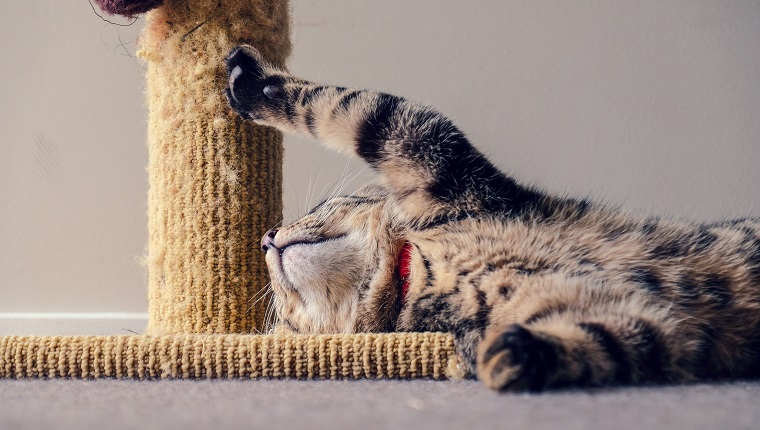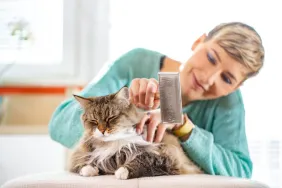Scratching is an intrinsic, natural feline behavior. Just like their brothers and sisters in the wild, a domestic cat needs to scratch.
Indoor-only cats feel an innate compulsion to scratch, but sometimes they do it in inconvenient places — like the leg of a chair or your favorite couch.
They usually pick a small number of highly visible items in their environment to use for scratching. This marks their territory for anyone who might be walking by.
Important: There’s no way to stop a cat from scratching nor should you want to. But you can teach an indoor cat to scratch in acceptable places. A scratching post or cat tree is necessary for the cat to do their scratching appropriately.
Here’s what you should know about scratching, and what you can do to redirect your cat’s clawing behavior.
Why Do Cats Scratch?
Generally, cats scratch to accomplish the following:
- Communicate: This is where I live.
- Mark territory: Sweat glands in the cat’s foot pad leave a scent reminder that this is a cat’s area. Other cats smell it and know where their friend – or enemy – has been.
- Exercise: Cats scratch for exercise. The act of stretching and scratching is pleasurable and keeps the cat’s muscles toned. Think how good it feels when you stretch first thing in the morning.
- Shape up claws: Scratching removes the dead outer layer of the front claws, allowing the new nail to grow underneath.
How To Use Scratching Posts To Redirect Behavior

Any scratching posts you get for your cat should be at least three feet tall with a sturdy, solid base. The cat needs to be able to reach up, dig their claws into the top of the post, and pull them all the way down to the bottom of the post.
This stretches their spine and muscles properly and exercises their claws. A cat tree with room to scratch or climb and cubby holes to burrow into gives a cat multiple opportunities to exercise their muscles and claws.
Make sure the scratching post and cat tree are sturdy and balanced so they don’t topple over when your cat jumps or climbs on them. If a piece of equipment falls over and scares your cat, they might never use it again.
Remember to check the material on the scratching post. Good scratching posts often are covered in sisal, a rope-like material that cats prefer.
If your cat is scratching on your carpet or couch, you don’t want a scratching post covered in similarly textured material. This confuses your cat and makes them unsure of where they should scratch.
Some cats like to scratch horizontally — for them, there are inexpensive scratchers made of corrugated cardboard.
To entice your cat to scratch in the right place, rub some catnip on the scratching post. Reward the cat with a treat the first few times they use the post to reinforce this appropriate behavior.
With any luck, your cat will get the hang of it quickly. And your couch, curtains, and favorite chair will remain intact.
Does your cat like to scratch? How do you make sure they stick to their scratching post instead of the furniture? Let us know in the comments below!









